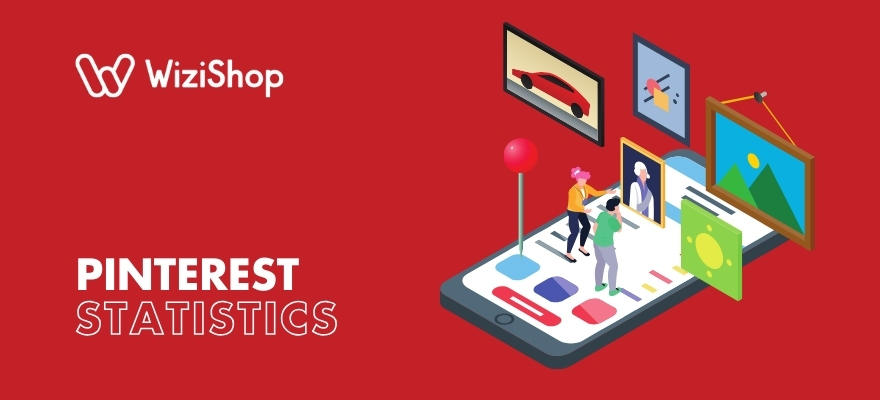Key points in this article:
- As of Q3 2025, Pinterest counted 600 million monthly active users worldwide.
- The largest user base is in the United States (≈ 96.9 million people), but other top countries include Brazil, Mexico, Germany, France, and the UK — showing Pinterest’s strong international reach.
- The platform’s audience skews heavily female (about 70.3%).
- Pinterest’s largest age group is 18–24 years old, followed by 25–34 — indicating that young adults remain the core users.
- In 2024, the company generated over $3.6 billion in worldwide revenue.
Pinterest is something of a free spirit in the world of social media platforms because its usage is unlike any other. Different from Facebook, Instagram, YouTube, LinkedIn, Snapchat, or TikTok, Pinterest allows visitors to enjoy a wide selection of inspirational images and videos, on mobile and desktop.
Pinterest is first and foremost a visual search and discovery engine. The social media site and app are intended to serve as a source of inspiration and information for visitors in at least a billion areas.
Today, Pinterest users, or “Pinners,” can find billions of unique visuals, photos, videos, gifs, and infographics in the form of “Pins,” which are themselves grouped into thematic boards.
As one of the most active social media platforms, Pinterest boasts impressive numbers that underscore its expansive reach and diverse demographics. What are the key figures to remember to improve your content marketing efforts over time, boost your brand’s presence on the social media app to reach a larger audience with your Pins, and get ready for the future?
This article delves into the latest Pinterest statistics, offering insights into how it stands out among competitors and continues to attract a wide array of active users. These stats highlight the social media platform's significant influence and potential for engagement.
Key global stats for Pinterest
Pinterest is a singular network, and cannot be compared to Facebook statistics, Snapchat statistics, Instagram statistics, or LinkedIn statistics. So let’s find out what Pinterest’s key global statistics are.
How many monthly active Pinterest users are there around the world?
According to Statista, as of Q3 2025, the social media network had 600 million monthly active users worldwide.
This represents an increase of approximately 11.7% compared to the same time in the previous year.
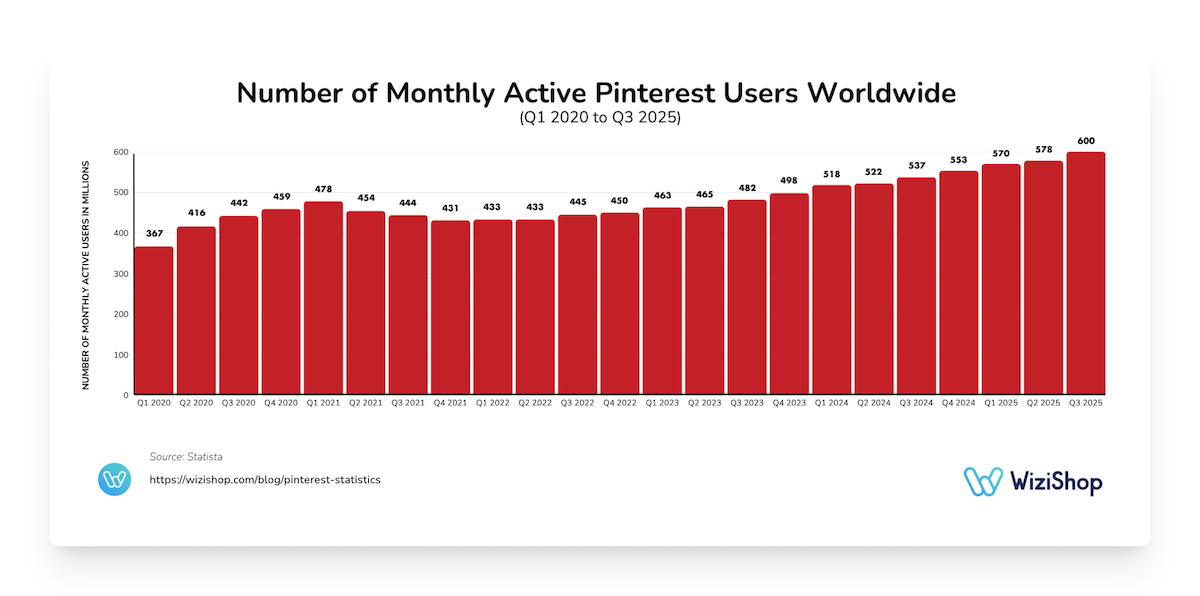
What country has the most Pinterest users?
Pinterest is a popular social media platform worldwide, with usage increasing in many countries every year. As of October 2025, Statista stats show that the country with the largest Pinterest audience is the United States, with 96.9 million users, followed by Brazil with 42.22 million users and Mexico with 28.52 million users.
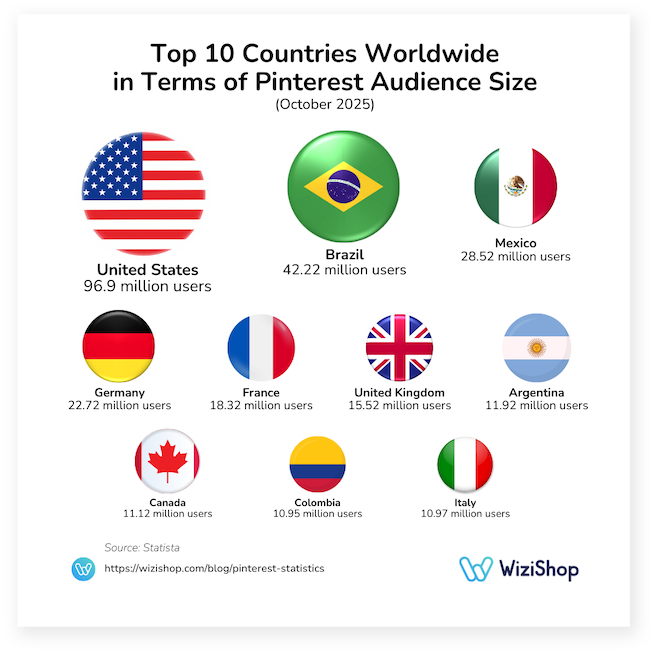
The top 10 countries in terms of Pinterest audience size along with their user counts are listed below:
| Country | Number of Pinterest users |
|---|---|
| United States | 96.9 million users |
| Brazil | 42.22 million users |
| Mexico | 28.52 million users |
| Germany | 22.72 million users |
| France | 18.32 million users |
| United Kingdom | 15.52 million users |
| Argentina | 11.92 million users |
| Canada | 11.12 million users |
| Colombia | 10.95 million users |
| Italy | 10.87 million users |
Source: Statista
Another Statista report additionally shows that Pinterest’s audience in the United States is predicted to grow 5.25% from 2024 to 2028.
What is Pinterest’s revenue?
As with previous years, Pinterest’s revenue saw a dip in growth at the beginning of 2025, but the social network largely made up for it later in the year, earning $855 million in Q3 2025 alone, according to Statista.
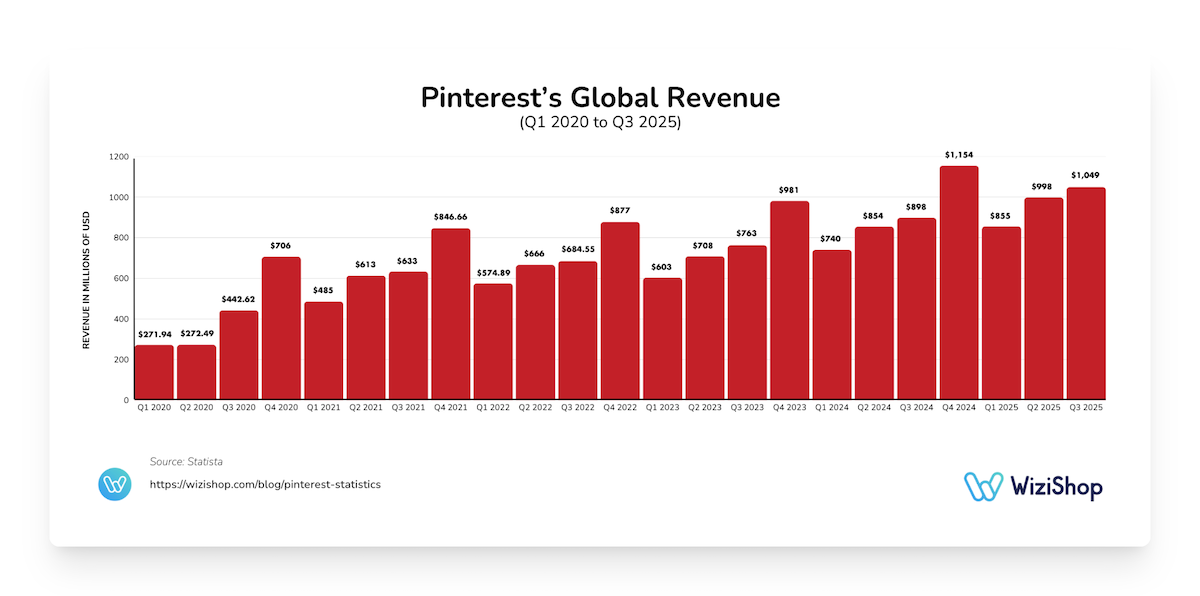
Statista data also shows that Q4 2024 marked Pinterest’s highest quarterly revenue performance in the company’s history (so far) with earnings of $1.154 billion. Pinterest earned a total $3.646 billion in worldwide revenue for the entire year of 2024.
As of Q3 2025, Pinterest has generated $2.902 billion in revenue for 2025, and with one quarter left to go, it’s quite likely that it will surpass its total earnings from 2024.
How popular is Pinterest compared to other social media platforms?
In terms of social media popularity based on the number of global monthly active users, Pinterest is in 14th place, according to Statista data from February 2025, ranking below other top social media platforms like Facebook, Instagram, WhatsApp, YouTube, TikTok, WeChat, Telegram, and others.
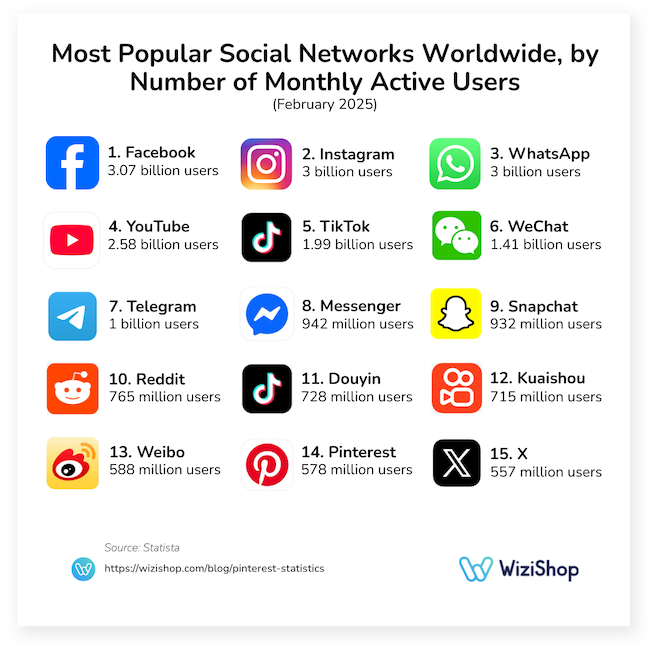
Pinterest audience: Key user demographics and behaviors
The Pinterest platform has transcended its basic functions to become a vital source of inspiration and commerce on social media.
In this section, we explore key demographics of Pinterest’s users and how the social network’s unique features continue to shape user interactions and usage on a global level.
What gender uses Pinterest the most?
As of January 2025, women made up the majority of total Pinterest users worldwide, with female users representing 70.3% of the global population on Pinterest compared to 22.4% of users being male and 7.3% of users being of “unspecified” gender, according to data in Pinterest’s planning tools shared by DataReportal.
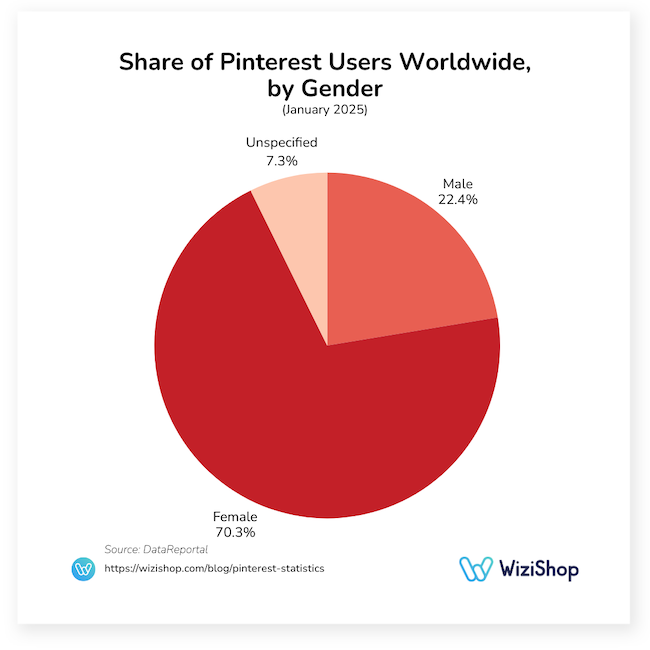
How old are Pinterest users?
DataReportal notes that Pinterest’s tools report that the highest proportion of users in Pinterest’s global advertising audience is those aged between 18 and 24 years old at 27.2%, followed closely by users aged between 25 and 34 years old at 24.6%.
Here, you can find more information about different age groups and their share of Pinterest’s advertising audience as of January 2025:
| Age group | Share of global advertising audience (18+) |
|---|---|
| 18–24 years old | 27.2% |
| 25–34 years old | 24.6% |
| 35–44 years old | 14.5% |
| 45–54 years old | 9.5% |
| 55–64 years old | 7.1% |
| 65+ years old | 4.7% |
Source: DataReportal
The younger generation is reacquainting itself with the Pinterest application: like TikTok or YouTube, images and video are now central to the consumption of information.
In fact, according to Pinterest, the platform’s fastest growing audience is Gen Z, comprising 42% of its total global audience, who search more and save more Pins than other generations.
Pinterest stats also report that the #1 reason that Gen Z uses the platform is for obtaining information concerning brands or products.
What are the top user activities on the Pinterest social media platform?
Statista stats from a study of Pinterest users based in the United States and the top reasons they use the platform show that almost half (49%) of the people on Pinterest use the social media app for entertainment.
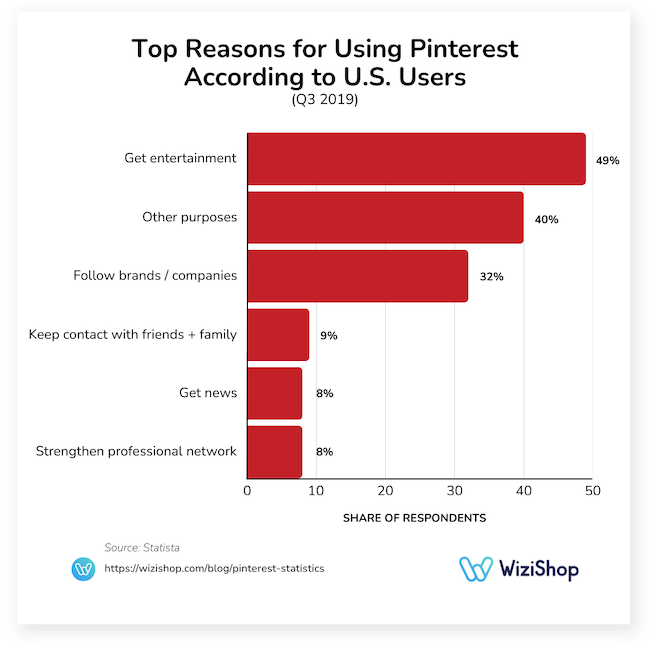
A statistic that will be particularly interesting to marketers hoping to expand their brand's reach via social media marketing is that 32% of Pinterest users use the platform to follow brands and companies.
Additional ways that people in the study of U.S. active users reported using Pinterest include for other purposes (40%), to stay in contact with loved ones (9%), to get news (8%), and to grow their professional network (8%).
What are Pinterest users searching for on the social media platform?
Well, it varies depending on where users live. By heading to Pinterest Trends, you can select a region and find out what people have been searching for most frequently in the last 30 days.
For example, according to Pinterest, for users in the US, the top search trends from approximately mid-October to mid-November 2025 were as follows:
- fall nails
- pumpkin carving ideas
- fall outfits
- nails
- pumpkin painting ideas
- Halloween nails
- winter hair braid
- winter fashion inspo
- outfit ideas
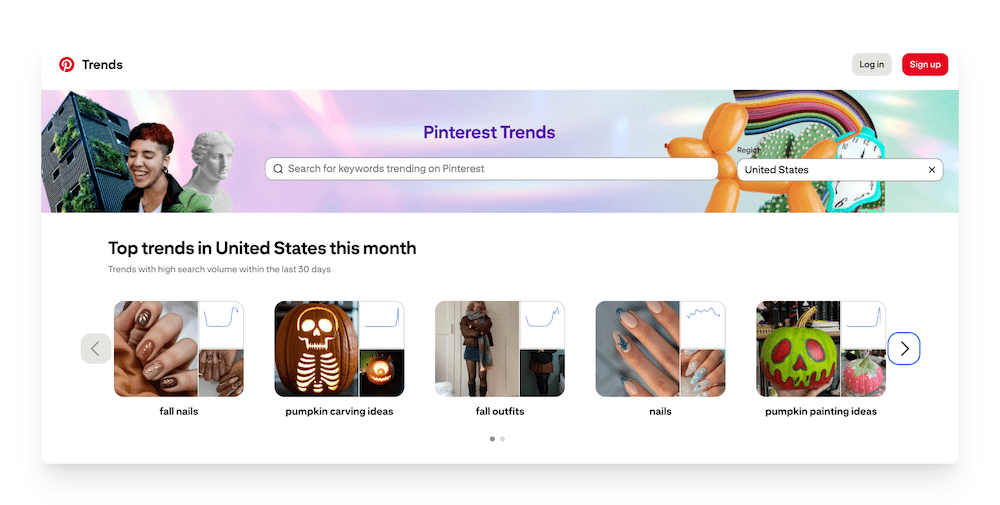
Source: Pinterest
Pinterest traffic statistics
How many visits does Pinterest.com receive?
Semrush reports that in October 2025, Pinterest.com attracted an estimated 1.25 billion website visits, a statistic that establishes it as one of the most popular global websites.
What country is Pinterest.com’s biggest traffic contributor?
In October 2025, the United States took the top spot, driving approximately 23.5% of the social media platform’s traffic worldwide, based on Semrush stats. This is no surprise considering that the US has the greatest number of Pinterest users worldwide.
In terms of device usage when accessing Pinterest.com in October 2025, about 63.5% of U.S. traffic originated from desktops, while around 36.5% came from mobile devices.
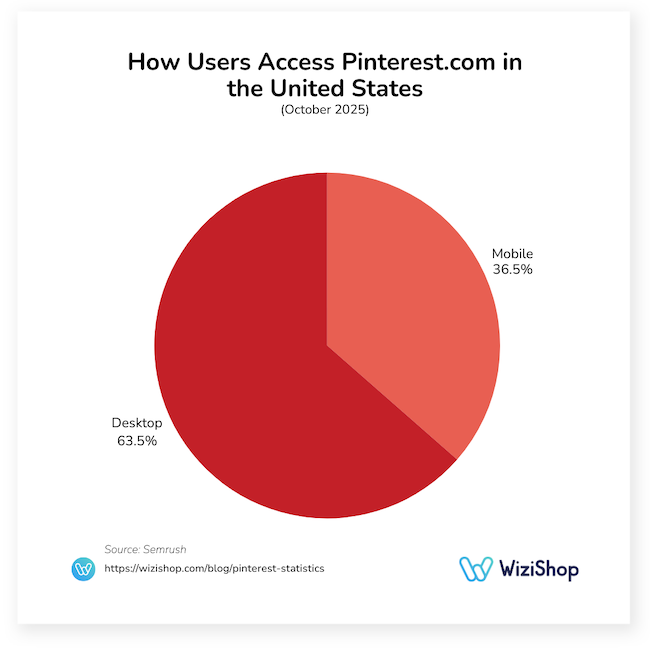
The countries that follow the US in having the highest distribution of visits to Pinterest.com are India, Brazil, the Russian Federation, and Germany, with their traffic shares listed below:
| Country | Share of global traffic to Pinterest.com in October 2025 |
|---|---|
| United States | 23.5% |
| India | 6.97% |
| Brazil | 6.26% |
| Russia Federation | 4.65% |
| Germany | 4.14% |
Source: Semrush
Pinterest advertising and marketing statistics
How do Pinterest ads compare to those on other social networks?
Want to cut costs on customer conversions with your advertising? Consider this statistic: Pinterest data shows that ads on the platform are 1.3 times more cost-effective per conversion compared to other social media ads.
In addition, recent data reveals that Pinterest ads significantly outperform competitors, generating 11.4 times more prospects than other social media platforms.
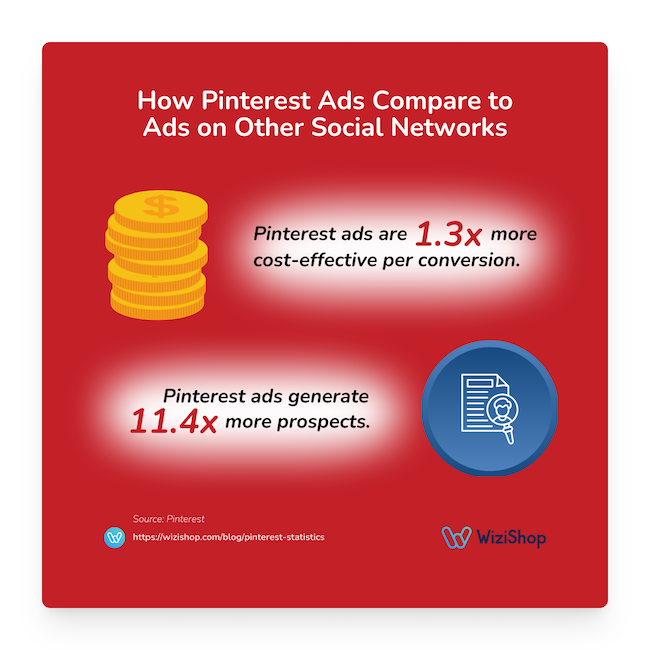
What kind of advertising is most effective on Pinterest?
If you’re hoping to improve your reach on Pinterest by investing in advertising, take note: the social media network’s data determined that Pinterest ads that elicited a strongly positive emotional response resulted in a 20% greater increase in recall and a sixfold rise in intent to act.
What share of searches are unbranded?
Here’s another statistic that's good news for marketers: 96% of top searches on Pinterest are unbranded, with users typically looking for generic items such as “green vase” or “rustic home décor” instead of particular brands. This statistic opens up a significant opportunity for your brand to get noticed.
Since Pinners aren’t strictly loyal to any single brand, they’re often on the lookout for new brands and products to purchase.
Pinterest Shopping statistics
In recent years, Pinterest has enhanced the shopping experience by making it possible for people to shop and purchase throughout the platform.
Pinterest is not only a good platform for increasing brand awareness; it can also help significantly boost sales for your business! Thanks to its Product Pins (formerly called “Shoppable Pins”), customers can easily make purchases with just a few clicks, streamlining the process of selling your brand’s products.
What share of users think of Pinterest as a place to shop?
In fact, 55% of users perceive Pinterest as a shopping venue, establishing it not only as a source of inspiration but also as a go-to site for purchasing items inspired by what people find there.
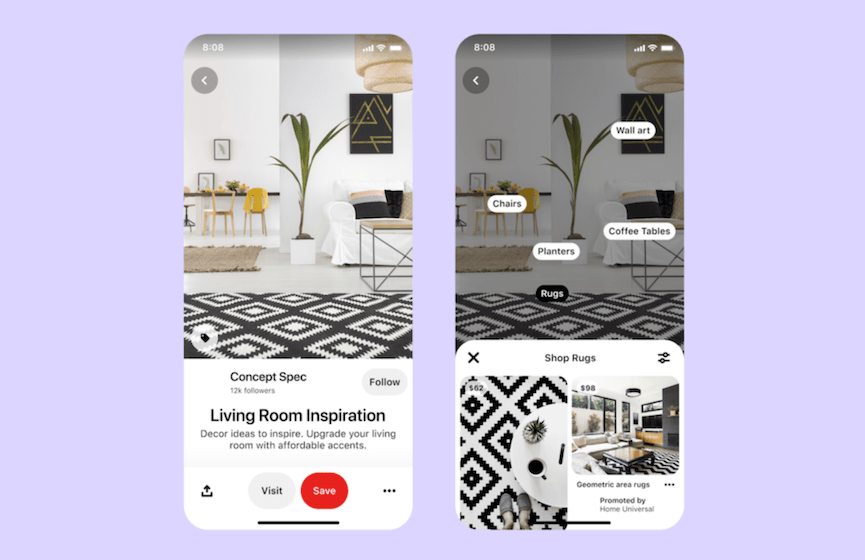
What impact can Pinterest have on users’ buying behaviors?
Want another interesting statistic to convince you of the benefits of being a brand or company selling on Pinterest? 83% of weekly Pinterest users have made a purchase after seeing content from brands on the platform.
Furthermore, engagement is quite high with people shopping on the platform, and they’re willing to pay more for products they adore. Indeed, Pinterest users spend 80% more each month compared to users on other social media platforms.

Pinterest Predicts 2025: Trends for individuals and businesses
Beyond raw numbers and user metrics, Pinterest’s statistics also reveal clear patterns in what people are actively searching, saving, and planning.
Pinterest Predicts brings these insights to life, transforming platform data into forward-looking predictions that creators and brands can use to stay ahead.
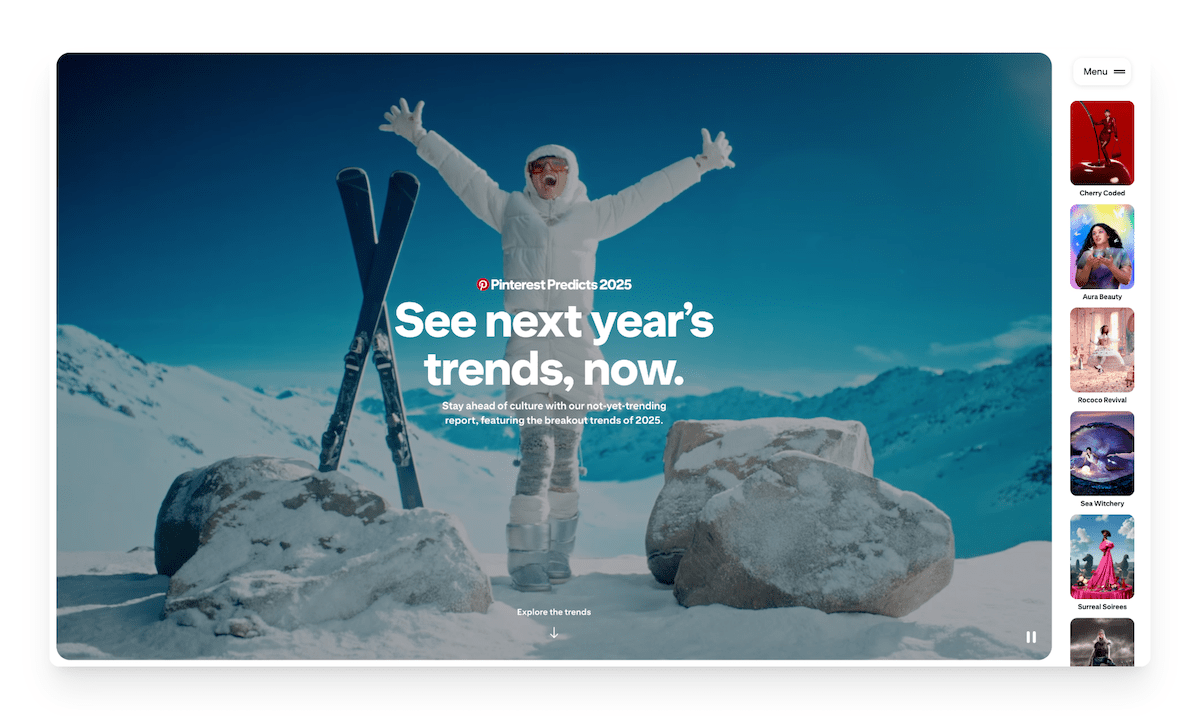
Source: Pinterest
This is the most comprehensive resource offered by the social network: Pinterest Predicts enables all professionals or individuals wishing to invest as much as possible in creating Pins on the platform to find out exactly what predictions the application is making through the study of user behavior.
Within a playful interface, each box contains data relating to the theme, with stats and data to boot.
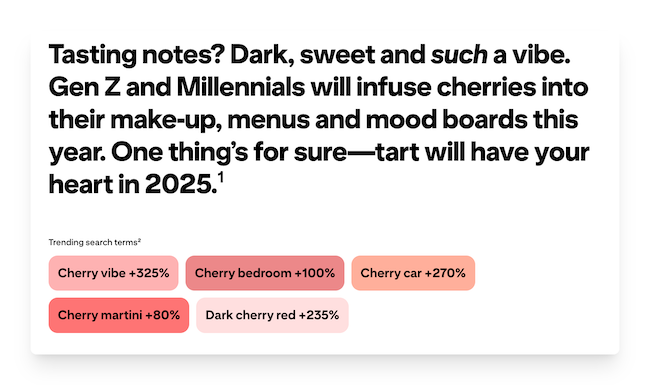
Source: Pinterest
Pinterest is a huge site bringing together resources from individuals and professionals on every theme, from tips and inspiration to design, blog posts, photographs, marketing infographics and more.
To discover all the categories, ideal for increasing your chances of selling on Pinterest, head to Pinterest Predicts.
Conclusion
Pinterest continues to be an active force in the global social media landscape, marked by growing revenue and traffic statistics year over year. This platform not only reaches a vast number of people but also appeals to a diverse range of demographics.
The statistics we’ve reviewed highlight how Pinterest maintains its relevance and influence among various social media platforms, driving significant engagement and economic impact.
As it evolves, Pinterest’s unique position within the digital ecosystem offers intriguing opportunities for users and advertisers alike to tap into its extensive reach and active user base.
If you don’t already have an active presence on Pinterest for your business, now’s a great time to add Pinterest to your digital marketing and advertising strategy and start creating high-quality content to pin on your future boards.
By optimizing your usage of the app and the content that you pin and share with other users, the platform can be an excellent way to reach more people in your target audience worldwide, drive traffic to your online store, and boost your total revenue this year and beyond!
Which Pinterest statistic surprised you the most? What’s your favorite way to use the social media platform for your brand? Let us know in the comments below!
Looking to further enhance your understanding of social media statistics? Don't miss out on our other articles for more helpful insights:


